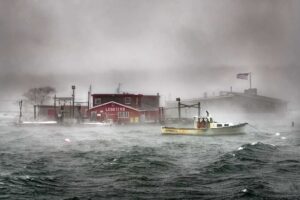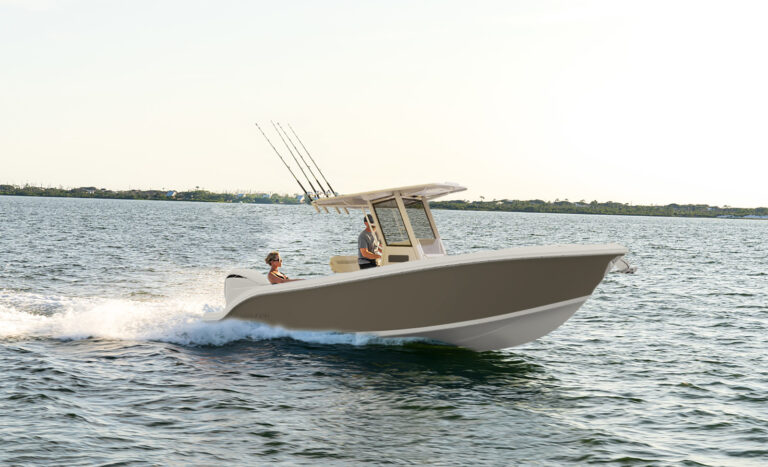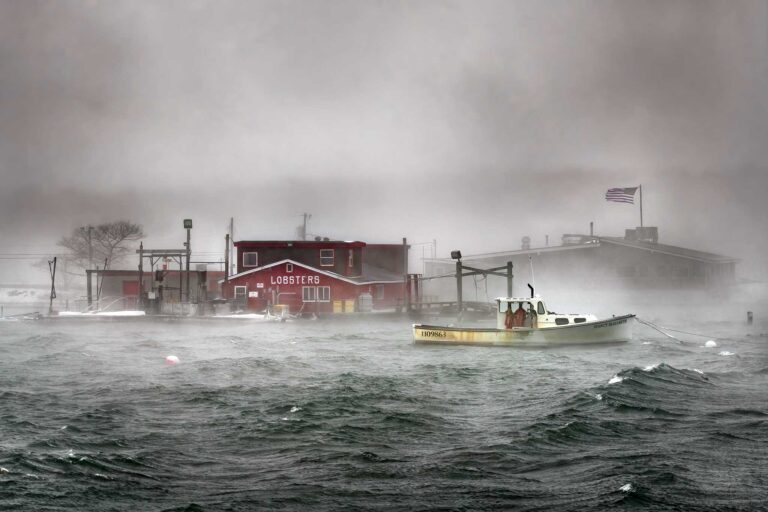At Marine Weather Center, a client recently asked why the computer model forecast predicted small seas on the windward side of Saint Martin, when what was really happening were strong winds and large seas. The answer had everything to do with how weather models are designed, how they work and how they don’t.
Weather forecast models are ubiquitous for good reason: They provide precise forecasts for weather information—such as wind, waves, temperature and precipitation—that we’re looking for, at precise times and locations. Or so it would seem.

Weather models have limitations, and understanding these limitations will help you better interpret their forecasts so you can stay safe on the water. Get ready to geek out on some serious meteorology stuff here.
What’s a Weather Model?
Weather models break the earth down into grid boxes, with each grid box representing a specific area on earth’s surface and the atmosphere above. Forecast models start by approximating the current state of the atmosphere, using recent observations from satellites, airplanes, weather balloons, buoys, airports and other land-based sources, as well as from ships at sea. If recent observations are not available, the model interpolates to “guess” an initial value for all weather parameters, in all grid boxes.
Once the model approximates the current state of the atmosphere, it performs mathematical calculations to predict the sea surface and land surface at future forecast times.

In general, the smaller the grid boxes, the better the forecast. But more grid boxes require more computing power, and even today’s best supercomputers cannot generate forecasts for enough grid boxes to resolve (and accurately predict) many weather phenomena—especially convective thunderstorms, tornadoes, hurricanes and other severe weather.
Also, guesses about the initial state of the atmosphere introduce uncertainties and inaccuracies at the present time, and these inaccuracies can be amplified at future forecast times. To compensate for this, many global models run “ensemble” forecasts that assume different initial states of the atmosphere. The U.S.-based Global Forecasting System (GFS) model assumes 30 of these different states. The European Centre for Medium-Range Weather Forecasts (ECMWF) assumes 50. Each then runs a set of streamlined calculations to yield, respectively, 30 or 50 different forecasts. Ensemble forecasts are typically averaged, resulting in an “ensemble mean” forecast, which can provide additional insight into what might happen if the “operational” (or primary) forecast is not correct.
The Space-Time Factor
Weather is fluid—it changes over time and distance. Sometimes weather changes are subtle, gradual or linear, changing at a constant rate; sometimes changes are dramatic, sudden or at a variable rate. Weather models handle the former well. but they lack the temporal (time) and spatial (size and location) resolution to predict many dramatic or sudden changes, as well as those that occur at a variable rate.

Spatial resolutions are determined by the size of the grid boxes that output forecast data. NOAA’s GFS model spatial resolution is about 13 kilometers (8 miles), so each grid box covers about 64 square miles. The European ECMWF has a finer spatial resolution of 9 km (under 6 miles)—each grid box is a bit less than 36 square miles.
In terms of time, both have a temporal resolution of one hour for short-range forecasts, out to 120 hours, or five days, for the GFS, and 90 hours, or just under four days, for the ECMWF. That resolution drops for each as they extend to 16 days for the GFS and 10 days for the ECMWF.
In both models, there is only a single forecast for each weather parameter (wind, temperature, etc.) within each grid box, and only a single forecast for the top of each hour for each grid box.
If a weather event—such as an increase in wind speed, change in wind direction, or decrease in temperature—occurs over an area larger than the resolution of the model (one grid box), then the model has some chance of properly predicting the event.

Similarly, if such a change occurs over a period longer than one hour (within the 90 or 120 hours that the model has a fine temporal resolution), then the model has some chance of predicting the event.But often, that’s not what happens in the real world.
Temporal Limits
Let’s focus on temporal resolution for a moment. If the wind increases from 10 knots at 6 a.m. to 15 knots at 7 a.m, peaks at 20 knots at exactly 8 a.m., then abates to 15 knots at 9 a.m., and 10 knots at 10 a.m., the model might provide a fairly accurate forecast. Graph 1 on the opposite page shows this, with the forecast model (blue bars) describing the actual wind (red curved line) fairly accurately, although it slightly under-forecasts increasing wind and over-forecasts decreasing wind.
But what if the wind increases from 10 knots at 6 a.m. to 12 knots at 7, then triples to 36 knots at 8:30 a.m., before settling to 14 knots at 9, and 10 knots at 10? Assuming the rate of change from 7 a.m. to 8:30 a.m. is linear, the model’s 8 a.m. forecast of 28 knots could be about right at exactly 8:00 a.m. But what about at other times? Graph 2 shows that the forecast model (blue) is a poor predictor of actual wind (the red curved line), missing peak wind badly, as well as under-forecasting increasing wind and over-forecasting decreasing wind.
In these examples, we assume the forecast model predicts wind perfectly—all of the inaccuracy is due to the model’s temporal resolution limitation. But if you were sailing in this weather, how would you rate the accuracy of this model? And, just imagine if we added model inaccuracy into this scenario.
Spatial Limits
Remember that sailor who asked about the weather on the windward side in Saint Martin, where there were much higher seas and wind than the computer model predicted?
The answer is that within about 5 miles on the windward side of the island, the grid box includes protected waters where seas are small, and that’s the forecast for the entire grid box. To get a better idea of actual seas on the windward side of the island, this sailor would be better off using the forecast for a bit farther from the island to ensure the entire grid box is over open waters.
Grid size and shape matter. Today’s best models use different shapes; the GFS uses cubed spheres, while ECMWF uses an octahedral grid. An experimental model (MPAS) uses a hexagonal mesh. You can’t assume the forecast grid box covering your area is square in shape.
Weather events occur at different scales as well. Pressure-gradient-driven wind—blowing generally from areas of higher pressure toward areas of lower pressure—occurs at a scale of hundreds or thousands of miles, is relatively uniform and linear, and persists for long periods of time. Computer models handle this sort of weather very well.
But convection—vertical motion of air due to temperature differences within the air mass—occurs at a scale of hundreds of feet to a few miles and may persist for only minutes to a couple hours. Today’s global forecast models do a poor job predicting convective thunderstorms and other severe weather, in large part because they lack the spatial and temporal resolution to resolve these events.
Additional Factors
Earth is big—about 500 million square kilometers. The grid boxes on our best global models (GFS, ECMWF, UKMet from the U.K. Met Office) are under 100 square kilometers in area. The GFS model predicts over 100 different weather parameters (wind, pressure, temperature, etc.) at 127 different vertical altitudes for 173 forecast times. That’s more than 10 trillion forecast values.
Today’s best supercomputers run these calculations in about an hour. (The GFS model runs on a pair of supercomputers which, as of late 2022, were the 49th and 50th fastest in the world. ECMWF runs on the world’s fourth-fastest supercomputer.) The ECMWF estimates that in the next decade, maybe by 2030, a combination of different grid box schemes and improved supercomputing capabilities may allow 1-km resolution global models.
Forecast models and computing power are constantly evolving. The GFS and ECMWF undergo major revisions every few years. (In 2021, for instance, the GFS increased from 64 to 127 vertical layers.) And there are minor revisions in between. Global model spatial resolution has been doubling every few years.
In the meantime, to better predict thunderstorms and other severe weather, many government meteorology agencies generate shorter-term, higher-resolution models (in the U.S., for instance, the HRRR, NAM and a few others) that offer in some cases 1-km resolution out to about two days. Typically, these are for coastal and near-shore waters only.
Now that you understand some limitations of weather models, you should be better able to interpret their forecasts. Remember that when you query a computer model forecast, the question you typically ask is: What is the weather going to do over a continuous timeline in my location? What answer will the model give you? It could show this model’s best guess about the weather in a particular geographic area, and just at specific times.
It’s best not to get caught in the “precision trap.” We often assume that if something is more precise, then it is more correct. Computer model forecasts are very precise, but they can be precisely wrong. I always recommend that sailors use computer model forecasts in conjunction with forecasts from your local meteorological office or a private forecasting service.
Chris Parker founded Marine Weather Center in 2010 to provide routing and forecasting services for private yachts. His story was originally published in SAIL magazine.
This article was originally published in SAIL, our sister publication, and in the July 2023 issue of Soundings.










